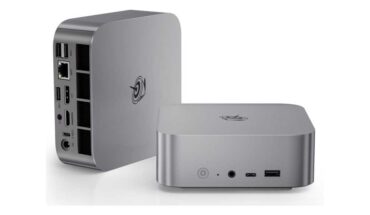Most people when trying to maximize their gaming experience focus on the quality of the game and their computer’s processing power. But an often-overlooked variable that can greatly affect the experience is a decent gaming headset. It’s especially important if you plan on getting the best out of multiplayer games, where you’re just as likely to use your headset to chat with friends as you are to use it as a strategic tool to help you win.
As you’d expect, there’s no shortage of gaming headsets out there. No one wants to wade through the myriad options only to settle on one that ends up leaving you disappointed. That’s why I’ve done all the heavy lifting for you, testing a ton of different headsets to find the best.
Why should you trust me? Because I’m a hardcore gamer and tech user like you, which means I’m always on the hunt for better gear to improve my own experience. More than that, I’ve spent many years weighing the pros and cons of the latest new-release gaming headsets, so you could say I know more than a thing or two about them.
SteelSeries Arctis Nova Pro Wireless – Best dual-purpose wired/wireless gaming headset / Best overall
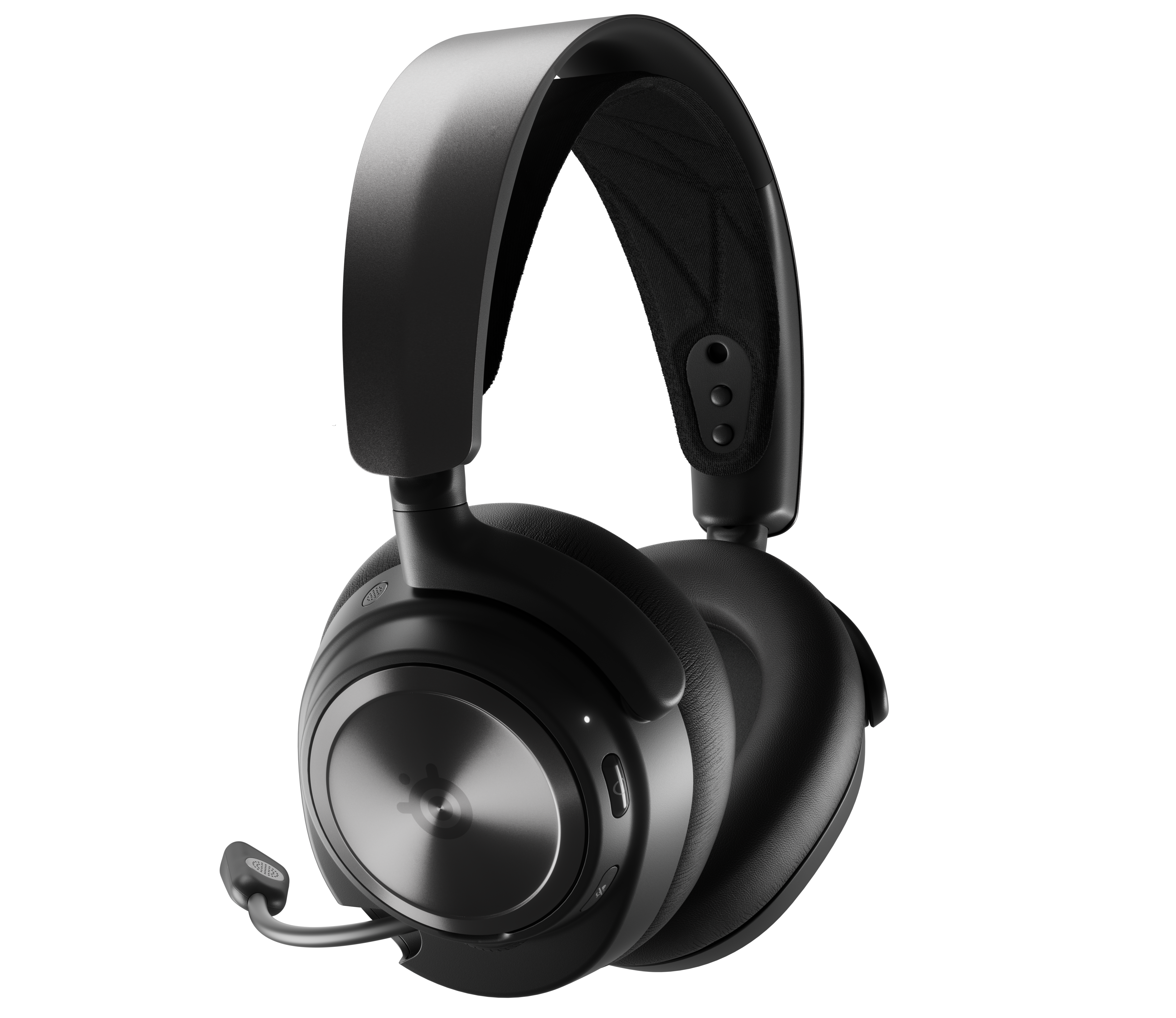
Pros
- Great-quality audio
- Dual wireless functionality
- Lots of software options for personalization
Cons
- Quite expensive
- Active Noise Cancellation won’t block out all external sound
Price When Reviewed:
$349.99
Why I like the SteelSeries Arctis Nova Pro Wireless
I have to nit pick very hard to find any flaws with this premium headset that offers the versatility of 2.4GHz Wi-Fi and Bluetooth wireless connectivity, as well as a wired connection. In wireless mode, it delivered crisp sound in 44.1KHz/16-bit standard resolution at up to 40 feet from my computer. But when I wanted to enjoy a richer sound, I could plug into a GameDAC controller that let me access a higher 96KHz/24-bit hi-res audio. The GameDAC also let me switch between my PC and Xbox One or Xbox X/S at the press of a button — which saved me the hassle of having to buy separate headsets for my consoles.
Active Noise Cancellation and 360 Degree Spatial Audio technologies also boosted the headset’s audio experience for me, the standout of the two being the latter, which utilizes 5.1 and 7.1 surround sound tracks to accurately reflect the direction of sounds. The SteelSeries Arctis Nova Pro Wireless also has the finest software support I’ve seen for a gaming headset, allowing me to choose from among 23 pre-made EQ presets designed for games like Counter-Strike: Global Offensive, Fortnite, Dota 2, Forza Horizon V, and Call of Duty: Warzone, to name just a few.
Who should buy the SteelSeries Arctis Nova Pro Wireless
Gamers serious about their audio setup who want excellent cross-platform compatibility, clear sound, and a spatial audio that better enables them to hear the direction of sounds in games. There’s a lot to personalize with the SteelSeries Arctis Nova Pro Wireless, so if you love tinkering with settings, this headset is just the ticket.
If you’re specifically after a wired headset, two other great options are the HyperX Cloud Alpha which has a tough metal frame and excellent audio fidelity, and the Astro A10 which also features great quality audio.
Read our full
SteelSeries Arctis Nova Pro Wireless review
Audeze Maxwell Wireless – Best audio quality
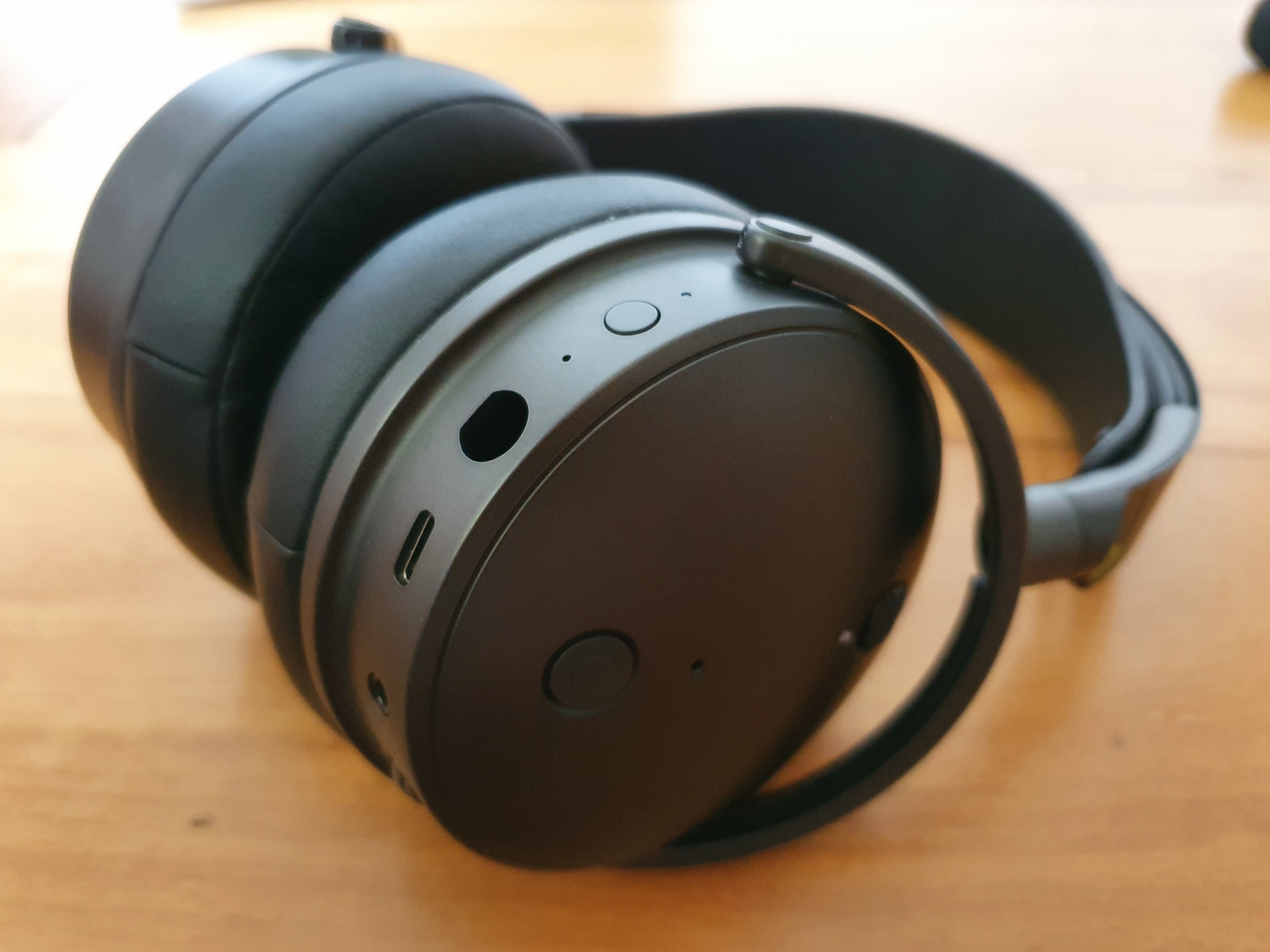
Pros
- Impressive audio that sounds warm and full-bodied
- Strong and robust design
- Excellent cross compatibility
Cons
- It’s quite heavy and large
- The headband isn’t extendable
- The software app is too simple
Why I like the Audeze Maxwell Wireless
It has undoubtedly the best audio of any gaming headset I’ve used. Audiophile-grade headsets are usually the domain of high-end music studios and not gaming dens. But Audeze’s Maxwell Wireless is an exception, being a studio-grade headset especially made for gamers. Its secret sauce is its 90mm planar magnetic drivers, which produce a more natural, full-bodied audio signature than headsets with 40- to 50mm neodymium drivers.
To fit such large drivers, the Maxwell Wireless is extremely big and heavy — it weighs a little more than a pound (490 grams). Although, you wouldn’t know by wearing it — the comfort onboard is very luxe; soft memory foam sits under plush leatherette for a premium feel and there’s an inner adjustable suspension band that balances out the headset’s weight across the top of your head.
The Maxwell Wireless works with just about any device — Windows PC, Mac, Xbox 360, Xbox X/S, Nintendo Switch, Android and iOS devices, and PlayStation 5. It supports Dolby Atmos for surround sound in games. For connectivity, you get a USB cable and an adapter for making a wired connection, a 2.4GHz USB-C dongle for low-latency Wi-Fi, and a 3.5mm cable for making an old-school analog connection. Although simultaneous Bluetooth isn’t available using the Wi-Fi dongle, you can still hook up simultaneous audio using the headset’s Bluetooth and a wired connection.
Who should buy the Audeze Maxwell Wireless
Anyone who’s really particular about the fidelity of their gaming audio and wants the best they can possibly find. Also, anyone who wants to use their gaming headset like a premium pair of headphones to listen to music. The Maxwell Wireless stands above many headsets for its sound quality, so if you’re an audiophile, it will definitely impress you.
Read our full
Audeze Maxwell Wireless review
Roccat Syn Max Air – Best RGB headset / Best for people who wear glasses
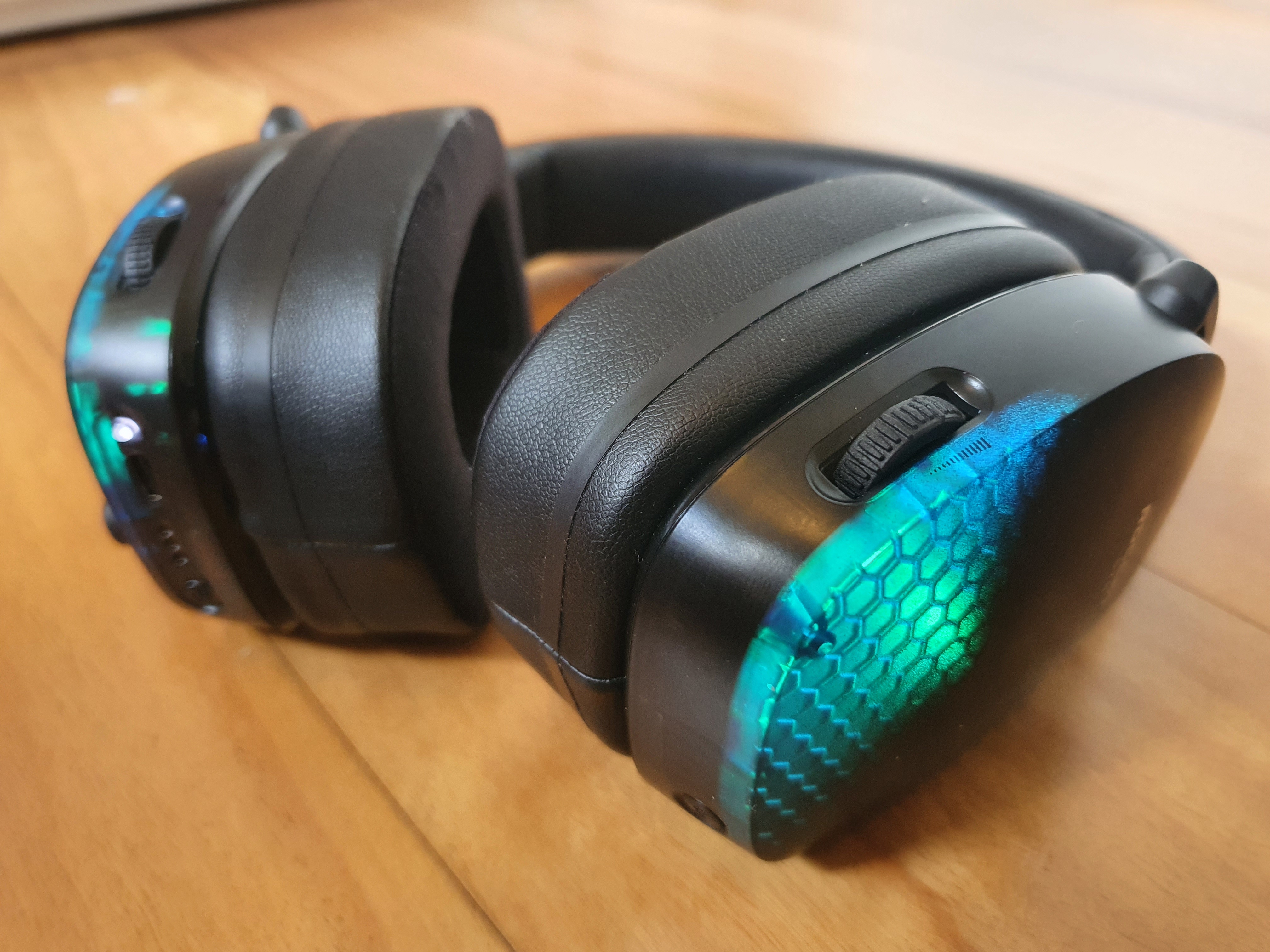
Pros
- The audio sounds balanced
- Simultaneous Wi-Fi and Bluetooth lets you listen to multiple audio sources at once
- The futuristic styling looks fantastic
Cons
- The microphone picks up a lot of ambient noise
- The controls are reasonably basic
- It’s expensive considering there’s no ANC
Price When Reviewed:
249.99
Why I like the Roccat Syn Max Air
I thought the Roccat Syn Max Air headset had a knockout futuristic aesthetic thanks to it cuboid shaped earcups that also have mesmerizing programmable RGB zones. The cups also feature ProSpec earpads, meaning if you wear glasses the frames will easily fit through the sides of the cups for a comfortable fit.
Looks aside, this headset impressed me with its list of gamer-centric features. Connectivity comes in the form of 2.4GHz Wi-Fi, Bluetooth, and a wired connection, and the Bluetooth can be used simultaneously with the Wi-Fi so that you can enjoy an extra audio source while gaming. In my review I thought its 50mm Nanoclear drivers produced a nice balanced sound that was a marked improvement over its predecessor the Syn Pro Air. It also comes with a convenient dock for charging between uses.
Who should buy the Roccat Syn Max Air
Players who want to rock the RGB look and be able to personalize the lighting effects in their headset. The headset’s spectacles-friendly design also makes it a great choice for gamers who wear glasses.
Read our full
Roccat Syn Max Air review
Logitech G Pro X 2 Lightspeed – Best 3D spatial audio / Best microphone

Pros
- Clear audio with fine detail in the sound
- Oozes comfort at every turn
- Pinpoint-accurate spatial audio support
- Mix of wireless and wired connectivity
Cons
- No Active Noise Cancellation
- Exposed cords could be a risk of breakage
- It comes with a soft case instead of a more robust case
Why I like the Logitech G Pro X 2 Lightspeed
At $250 the Logitech G Pro X 2 Lightspeed isn’t cheap, but this headset’s mix of clear audio with a deep and smooth bass range, comfortable earcups, and 3D spatial audio makes it ideal for gaming. It has three connectivity types: Bluetooth, 2.4GHz Wi-Fi, and wired (3.5mm auxiliary in), which means it connects to nearly any device. It also has a long battery life of up to 50 hours.
What’s really drawn me to this headset, though, is the fact that its DTS Headphone: X 2.0 spatial audio is one of the best I’ve used. It’s compatible with Microsoft’s spatial sound API, so its directionality is superb — you can even hear sounds from above very clearly. You can also tweak the volume of the sound emanating from each directional point in Logitech’s G Hub software app. The Logitech G Pro X 2 Lightspeed also benefits from Blue-branded software support in Logitech’s G Hub app, including presets that make it sound convincingly like a desk microphone — so its microphone is top quality.
Who should buy the Logitech G Pro X 2 Lightspeed
If 3D spatial audio is a must-have, the Logitech G Pro X 2 Lightspeed’s is one of the best you can get. Apart from that, the cans are so comfy, and the audio is so crisp, that most gamers are really going to dig this headset.
Be sure to also check out the Razer Barracuda Pro. This headset’s 3D spatial audio comes courtesy of THX Spatial Audio, which you can tweak and fine tune in Razer’s Synapse app. Or, if you’re really keen on the Logitech G Pro X 2 Lightspeed’s top-quality microphone but are on a budget, be sure to check out its predecessor model, the Logitech G Pro X, which has similar microphone fidelity but is a little cheaper.
Read our full
Logitech G Pro X 2 Lightspeed review
Corsair Virtuoso Pro – Best for streaming

Pros
- High-quality workmanship and elegant design
- High sound quality
- Two connection cables for flexibility
- Robust hardcase transport bag
- Multi-platform compatibility thanks to jack connection
- Many interchangeable parts
Cons
- High price
- Open design not ideal for noisy environments
- Hardly and sound shielding to the outside
Price When Reviewed:
$199.99
Why I like the Corsair Virtuoso Pro
With an open-ear design in the earcups, the Corsair Virtuoso Pro headset lets in more sound than most gaming headsets, which is perfect if you like to stream your games and want to monitor your own voice or hear your talent interviews in real time. The headset’s design is both elegant and comfortable too. Comfort comes courtesy of an adjustable headband, soft memory foam earpads, and a lightweight frame that weighs just 13.6 ounces (338 grams). The headset’s build quality is very decent — it’s comprised of robust plastic and metal.
In our review, we found that the Corsair Virtuoso Pro’s 50mm graphene drivers produced deep bass and clear treble tones with great detail. While that makes for a great audio experience while gaming, the lack of protective shielding in the earcups does mean that this headset isn’t that effective at blocking ambient noise, so it’s best used in quiet environments.
Who should buy the Corsair Virtuoso Pro
Aspiring or experienced content streamers or gamers who want to make Let’s Plays, walkthroughs, or game tutorials for YouTube or another video platform.
Read our full
Corsair Virtuoso Pro review
HyperX Cloud Mix 2 – Best for casual gaming

Pros
- Compact and lightweight
- Looks like a headphone and can be used just as well as one
- Plush and comfortable earcups
- The cups swivel and the headband is adjustable
- The volume wheel allows for precise control
Cons
- Hybrid listening mode needs a second to let sound in
- There’s no chat mixer wheel
- Lacks a dedicated boom microphone
Price When Reviewed:
199.99
Why I like the HyperX Cloud Mix 2
The HyperX Cloud Mix 2 looks and feels like a premium headphone, so it quickly became my go-to device for gaming at home as well as listening to music on the bus. The sound fidelity is awesome too — I was impressed by how easily it hit tones across the audio spectrum without any hint of distortion. The Cloud 2 is also very lightweight which meant I could wear it for very long gaming stints.
Who should buy the HyperX Cloud Mix 2
I recommend the Cloud Mix 2 to any casual gamers who want a device that they can use with just about any device they own. If you want to save some bucks and use your headset as a headphone, then these cans are just the ticket for that too.
Another excellent option for casual gamers is the ROG Delta S Wireless. This headset sports excellent audio fidelity and a robust build and comes with two sets of swappable earcups which allow you to swap the plush leatherette ones out for cooler mesh ones when they get too hot.
Read our full
HyperX Cloud Mix 2 review
Turtle Beach Stealth Pro – Best for FPS games

Pros
- Punchy audio that’s great for FPS games
- Solid attractive and versatile design
- Very good noise cancellation
Cons
- Lacks support for spatial audio
- The batteries need frequent changing
- It’s expensive
Price When Reviewed:
329.99
Why I like the Turtle Beach Pro
It’s a premium headset brimming with an almost complete list of premium features. It has excellent cross-platform compatibility and worked across almost all my devices. Plus, it has 2.4GHz wireless and Bluetooth connectivity, which meant I could wander away from my PC and still enjoy my gaming audio.
The Turtle Beach Pro sounded punchy with a great level of detail across the spectrum. It was especially well-tuned for FPS games like Halo, CounterStrike 2 and Battlefield I, where it delivered realistic thuds, clinks, and ricochets. A feature specific to Turtle Beach headsets called SuperHuman Hearing made it super easy for me to hear my opponents’ footsteps as they approached.
Who should buy the Turtle Beach Stealth Pro
Keen FPS gamers will really benefit from the headset’s punchy audio that’s ideally tuned for the games they play. The headset can easily pass off as a high-end headphone, so it will also suit gamers that want to use it on the fly.
Read our full
Turtle Beach Stealth Pro review
Corsair HS80 Max – Most comfortable design
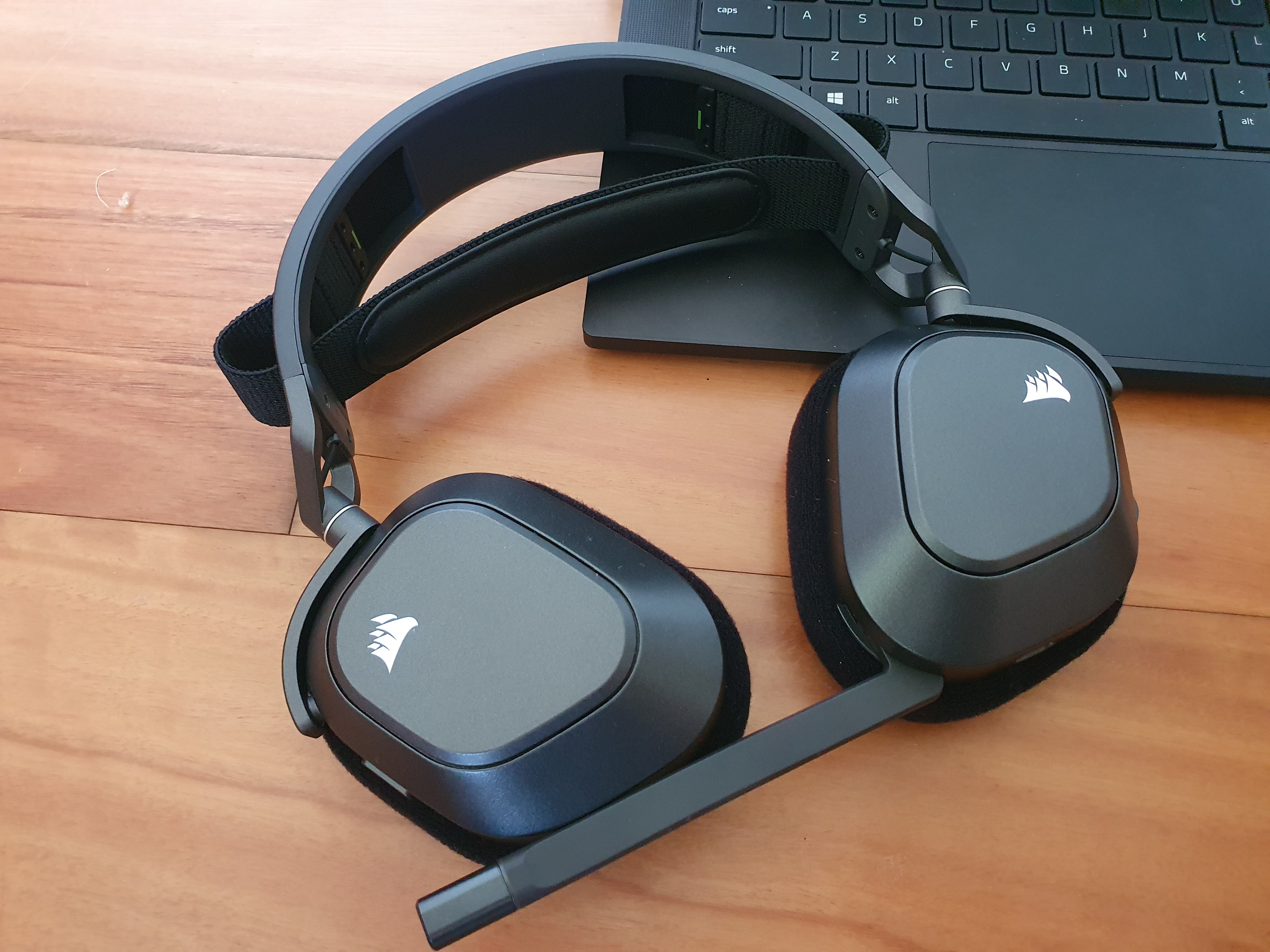
Pros
- Great audio performance with neutral mid-tones
- Lightweight, comfortable design
- Mesh coverings on the earcups minimize sweat
- Flip-to-mute mic
Cons
- The omnidirectional mic is not detachable
- Lacks true simultaneous audio for listening to multiple audio sources
- The small RGB light zones feel like an afterthought
Price When Reviewed:
179.99
Why I like the Corsair HS80 Max
Corsair has made a brave move to prioritize comfort for gamers even at the expense of what most gamers might expect from a premium gaming headset’s design. How so? The HS80 Max eschews leatherette for a cooling mesh fabric on its earcups, and swaps metal for plastic in the headband, making it extremely lightweight and relatively sweat-free for long gaming sessions.
On the audio front, the HS80 Max sounds terrific — its 50mm audio drivers produce a clear, high-resolution audio signature with neutral mid-tones, which really enliven sounds like footfalls and ricochets. It has both 2.4GHz low-latency Wi-Fi connectivity as well as Bluetooth, which you can’t listen to at the same time, but both connectivity types do have a long signal range that allows you to keep listening while taking breaks away from your rig. The non-detachable flip-to-mute mic does a great job reproducing natural-sounding speech for team chats.
Who should buy the Corsair HS80 Max
Anyone who suffers from sweaty, hot ears when they wear leather or leatherette covered earpads and want a cooler less sweat-inducing pair of cans. It’s also ideal for players that feel the burden of wearing heavy headsets and want a lighter option.
Read our full
Corsair HS80 Max review
Logitech G Astro A30 Wireless – Best wireless gaming headset
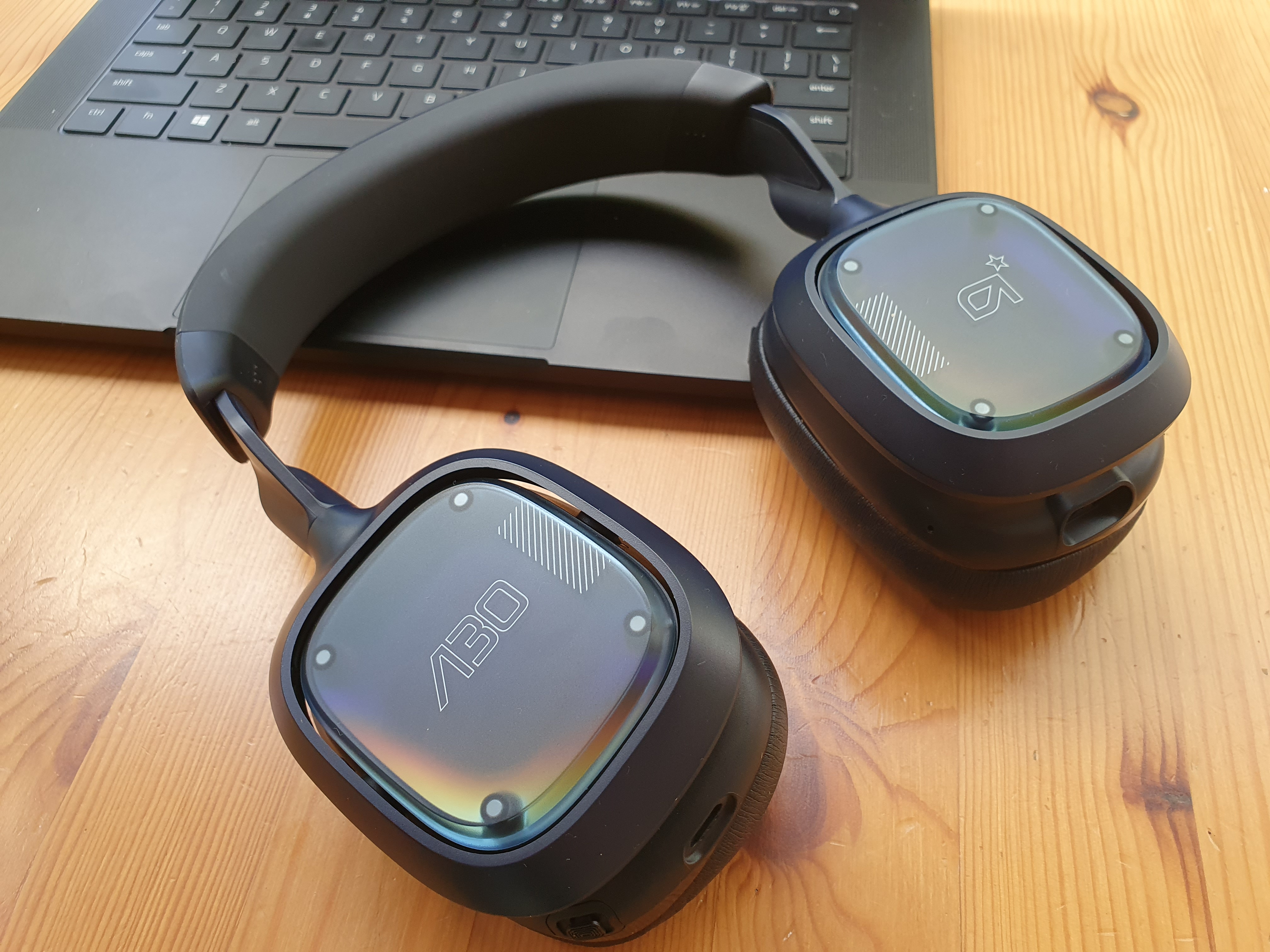
Pros
- The styling is very appealing
- The 40mm drivers produce a natural sound
- The cans are very soft and comfortable
Cons
- Some moving parts feel a bit tight
- Leatherette in the cups can get sweaty on hot days
- Battery life is decent but not excellent
Price When Reviewed:
229.99
Why I like the Logitech G Astro A30 Wireless
Not only does the Logitech Astro A30 produce a clear and natural sound, but its connectivity is also excellent. It sports dual wireless and wired connections with cross-platform compatibility, so you can easily hook it up to your PC, PlayStation 5, Xbox X/S consoles, or even a Mac. The headset’s Bluetooth can also be used simultaneously with a 2.4GHz Wi-Fi connection, which means you can take phone calls and participate in team chats, all the while losing absolutely none of your gaming audio.
All this functionality could have been delivered in a stock standard design, but the Astro A30 is one of the best-looking pair of cans I’ve seen in a long time. I especially like its plush leatherette earcups, stylish Astro logos, and removable speaker tags that you can swap out to personalize exactly as you wish.
Who should buy the Logitech G Astro A30 Wireless
Gamers that want a futuristic, trendy-looking headset with great sound and the option to personalize the headset’s look. Its excellent cross-platform compatibility will suit gamers that like to game on multiple devices.
Read our full
Logitech G Astro A30 Wireless review
Logitech G Astro A50 Wireless – Best wireless gaming headset runner-up

Pros
- Charging cradle is smaller and still very unique
- Switches to the more reliable 2.4GHz band (finally)
- Comfortable and durable
Cons
- Middling battery life
- Poor noise isolation
- Expensive
Price When Reviewed:
$299.99
Why I like the Astro A50 Wireless
Although expensive, the Astro A50 is dependable, providing decent sound over a quick 2.4GHz wireless connection. The audio drivers located in the A50’s earcups deliver strongly through the mid-range so the A50’s sound is warm and punchy in games and while listening to music.
While previous Astro wireless gaming headsets have featured large chunky charging cradles, the A50’s is quite compact so it takes up much less space on your desk. The cradle also has a built-in display so that you can tell which EQ profile you have selected, or whether you have Dolby or stereo modes switched on.
Who should buy the Astro A 50 Wireless
Anyone who likes the convenience of simply being able to store and charge the headset in a charging cradle between games. The built-in display is also really nice to have. It’s a feature that should appeal to gamers who like to tweak and refine EQ profiles for their games.
Read our full
ID10277 (2019) review
Turtle Beach Stealth 600 Gen 3 – Best budget wireless gaming headset

Pros
- Clear refined audio profile
- Great control selection that you can personalize further
- Attractive and comfortable design
Cons
- PC and PlayStation versions lack XBox connectivity
- No USB-A to USB-C adapter
- Slightly heavier than the previous generation
Price When Reviewed:
99.99
Why I like the Turtle Beach Stealth 600 Gen 3
It has just about everything I want in a gaming headset — a comfortable and lightweight design, excellent cross-platform compatibility options, and a whole lot of controls.
It also has both 2.4GHz Wi-Fi as well as Bluetooth connectivity. I also really like Turtle Beach’s SuperHuman Hearing, which is a Turtle Beach-specific feature that accentuates some game sounds like player footfalls. An exceptionally long battery life of up to 80 hours meant I could go for days without a recharge, too.
The Turtle Beach Stealth 600 Gen 3 also features a flip-to-mute microphone with AI noise cancellation, which produces clear-sounding audio in my gamer chats. Thanks to the 10-band EQ chart in the headset’s companion app, I could really fine-tune the audio profiles for my games, which isn’t something I can do with every gaming headset.
Who should buy the Turtle Beach Stealth 600 Gen 3
Casual gamers who want an all-around great headset with decent sound and a whole lot of gamer-centric functionality. At just $100 the Turtle Beach Stealth 600 Gen 3 punches well above its price range on the balance of its features and functionality, so gamers on a budget can save money on these cans.
Also consider the step-down Turtle Beach Stealth 500 as another great sub-$100 gaming headset. This headset lacks some of the durability and functionality of the Stealth 600 Gen 3, but it weighs a lot less and has virtually no clamp pressure, so it’s a great option if you want your headset to feel like it’s barely there.
The HyperX Cloud Core Wireless is also an excellent option in this price range. It has a durable aluminum frame, comfortable memory foam earpads, a detachable microphone, and also features DTS Headphone: X support for an immersive spatial audio experience.
Read our full
Turtle Beach Stealth 600 Gen 3 review
Razer Blackshark V2 Hyperspeed – Best mid-range wireless gaming headset

Pros
- Ultra-light and comfortable
- Excellent microphone quality
- Long-lasting battery life and fast charging option
- Versatile connectivity options
Cons
- Sound tuning favors esports
- Material quality could be better
- Non-detachable microphone
Price When Reviewed:
$129.99
Why I like the Razer Blackshark V2 Hyperspeed
The headset’s microphone quality is very close to broadcast quality. It also weighs less than 10 ounces, so it’s ultra-light weight. Despite that, it has large 50mm audio drivers that cover a broad frequency spectrum of 12Hz to 28KHz and produce a detailed soundscape with a low bass tone. The headset’s connectivity is also very good, with all three connectivity types available: 2.4GHz Wi-Fi, Bluetooth, and a wired connection via USB-C.
Who should buy the Razer Blackshark V2 Hyperspeed
Tech-savvy gamers that want a lightweight headset and want to sound fantastic in voice chats. The Blackshark V2 Hyperspeed is also a very decent headset for gamers wanting to record Let’s Plays. It’s also a little cheaper than some headsets, so its suits those with mid-range budgets.
Another great mid-range option is the Logitech G935. It won’t break the bank but includes high-end luxuries like a folding boom mic, dongle storage compartment, and stylish leatherette earcups.
Read our full
Razer Blackshark V2 Hyperspeed review
HyperX Cloud III Wireless – Best battery life

Pros
- High-quality design and good workmanship
- Multi-platform compatibility
- Detachable microphone
- Above-average battery life
Cons
- Occasional sound fluctuations in DTS surround sound
- Microphone adjustment required in noisy environments
- No Bluetooth
Price When Reviewed:
$169.99
Why I like the HyperX Cloud III Wireless
HyperX’s Cloud III Wireless headset doesn’t ace any one particular category but hits the right notes for comfort, sound, and design. In our review we found the headset’s driver configuration produces a balanced sound image with precise bass and treble tones. The headset’s best quality, however, is its long battery life that can last a full 120 hours operating at 50 percent volume.
The Cloud III wireless works with PS4, PS5, and Nintendo Switch consoles as well as PC; however, if you want to use the headset’s DTS surround sound, nothing less than a Windows PC with HyperX’s Ngenuity software app loaded on it will do. This headset is best for gamers who like the benefit of wireless connectivity only, since wired connectivity is not available (it’s 2.4GHz wireless connectivity only). It comes with a 10mm detachable microphone with a pop filter that does a great job muffling unwanted noise.
Who should buy the HyperX Cloud III Wireless?
The Cloud III Wireless is best suited for gamers who want a strictly wireless headset. Thanks to its long battery life, it’s an especially good option for gamers that like to get their gaming fix on the go — so players of handhelds will really dig it.
Read our full
HyperX Cloud III Wireless review
How I test gaming headsets
Because no two gaming headsets are the same, I put each product through a thorough testing protocol. I analyze everything from how comfortable and durable they are, to how they perform in games and the software support they get via their manufacturer’s apps. Here’s a list of the main categories I look at:
Design and comfort
You’ll spend an awful lot of time wearing a gaming headset, so it’s vital that it feels comfortable. Here I look at design features that either add or subtract from your overall comfort experience—features like a headset’s shape and weight, how well it fits on your head, and the amount of padding in the earcups. But design also plays a big role in a headset’s functionality, so I also look at how adjustable the band is, and how accessible the controls are.
Audio quality
There’s no point owning a headset with comfortable leatherette earcups if it can’t muster a decent sound. That said, I do a lot of listening to get an overall impression of a headset’s audio quality. I take notes on the clarity of the sound, how well the headset produces pitch, and in the case of wireless headsets, how much signal interference there is. My listening is guided by what I know about the headset’s hardware or software. For example, if a headset has Active Noise Cancellation (ANC), I’ll investigate how well the headset can isolate sound and block out noise. I also test the microphone, listening for muffled sounds, static, robotic noises, and any echoes—all signs there could be a problem.
Software support
With audio technologies getting ever more complex, gamers have more tools at their disposal than ever via headset apps. Technologies like Hi-Res audio, Spatial Surround Sound, and Parametric EQ all spring to mind, which is why I look closely at the kind of software support on offer.
For more details about the criteria I use to test each product and some helpful buying advice, be sure to read my rundown of how we test gaming headsets at PCWorld.
FAQ
Should I get a wired or wireless gaming headset, or one with both connectivity types?
Historically, gamers have mostly chosen wired headsets over wireless ones. That’s because, until recently, wired headsets were considered much better at delivering fast and secure audio signals than wireless headsets. Nowadays, thanks to the adoption of faster 2.4GHz Wi-Fi band technology, wireless headsets can also transmit audio signals very quickly and with minimal interference.
Consequently, if you’re a casual gamer and not too fussy about the very miniscule risk of your audio dropping out, a wireless headset should be completely fine for your gaming needs, the main advantage being you’ll get tons of extra mobility while still being able to listen to your game’s audio—something you don’t get when you’re tethered by wires.
Admittedly though, if you’re a serious gamer or esports player, you may still want to avoid that small chance your wireless signal will suffer some degree of loss or interference—even if that’s less likely than ever. If the stakes are high, a wired set will provide a little more surety that you won’t miss any crucial game moments, which could make all the difference in a closely contested match.
If you can’t decide, there are headsets now like the SteelSeries Arctis Nova Pro Wireless that provide both wireless and wired functionality in one easy unit and can switch between these modes in less than a minute. These headsets can cost significantly more, so be willing to pay for the privilege.
What else should I know about gaming headset connectivity?
Another thing to consider is which devices you might want to connect to, since wired and wireless headsets have different compatibilities. For example, most wired headsets connect to your computer via a USB-C connection, but unlike many wireless units, some also have 3.5 mm audio jacks, so they tend to be compatible with a broader number of devices—like smartphones, gaming consoles, and tablets.
Wireless devices on the other hand, connect to your device via a USB-C dongle or Bluetooth connection, which does narrow the number of devices you can use them with to either those that are Bluetooth compatible, or that come with USB-C ports.
Why is comfort a big factor in choosing a gaming headset?
While you can possibly do without fancy styling, you should never buy a headset that’s going to cause you discomfort. That’s because even a small amount of force or abrasion from wearing your headset can be extremely unpleasant and result in neck pain, a rash, cranial pressure or worse.
A huge consideration here is how your headset fits on your head and ears. Granted, you won’t always have the opportunity to try them on, it pays to look closely at PCWorld product reviews where our reviewers have done the wearing for you and have summarized how they feel, even after extended periods of time with them on.
You should also pay close attention to product descriptions for the features that indicate that a manufacturer has made comfort a priority. Things you’ll want to tick off your check list are:
a) The headset has a flexible band to minimize pressure and that the band is height adjustable to fit your ears. There is sufficient padding on the earcups, and the material is hypoallergenic, so it won’t cause skin irritation.
b) The earcups are easily rotatable—since this will ensure they move with your head as it moves. If possible, you should avoid headsets that are excessively heavy, or tightly fitting, since the added weight and clamp force will undoubtedly cause problems. When it comes to comfort, the more premium headsets tend to do better, so again it can be a matter of paying more to get more.
What kind of build quality and styling should I look for in a gaming headset?
Although wear and tear is an inevitable result of using a gaming headset, some will stand up to the rigors of gaming better than others simply because they’re made from tougher stuff. Ideally, you’ll want a gaming headset that has a metal frame and headband for durability, since plastic ones break quite easily. Metal bands also look more premium, so it’s a win-win.
Cushioning for the headband and earcups can be made from leather, velour, pleather, or foam. Leather and pleather (fake leather) look and feel luxurious. They also tend to be the most resistant to wear, but these materials aren’t very breathable and can cause sweaty ears during long gaming sessions. Foam is the opposite in that it’ll keep your ears cool but disintegrate quicker. Sitting between the two, velour keeps your ears relatively cool but tends to be fairly resistant to wear and tear.
That’s more of a general rule than an absolute. If you do prefer a material other than velour you can buy anti-sweat or abrasion-resistant covers for your headset’s earcups, which will help them last a little longer.
If your headphones do succumb to wear and tear, some manufacturers offer the option of purchasing and swapping out damaged parts. Replacing your earcups can refresh your headset’s look and feel. But having a headset with replaceable cabling can actually save you from having to buy a whole new set if the cabling wears right through.
Is noise isolation worth having in a gaming headset?
How well your gaming headset isolates noise makes a big difference to its sound quality. This is especially the case when you’re playing first-person shooters (FPS), where external noise can make it more difficult to locate the direction of sounds, like the footsteps of approaching enemies. In marketing materials, manufacturers will often use terms like Active Noise Cancellation (ANC) and passive noise isolation, but these terms mean quite different things. Here’s a quick definition of each:
a) Passive noise isolation: How well a headset can block out external noise just by forming a physical noise-blocking barrier over your ears.
b) Active Noise Cancellation: A technology incorporated into your gaming headset that actively blocks or filters out ambient noise so the sound you hear is the clearest it can be.
If possible, you’ll want a headset that sports both passive noise isolation as well as ANC, since these noise-blocking measures both have benefits. Passive noise isolation tends to be better at blocking out higher-pitched sounds, whereas ANC is more effective at blocking out lower-pitched sounds—like background noise and the sound of traffic. How well ANC and passive noise isolation work can vary greatly among headsets, so it’s worth doing your research to find a headset that makes the cut.
Why is surround sound important for a gaming headset?
Of all the technologies that come packed into gaming headsets, this one provides arguably the best tactical advantage for gamers. Headsets with surround sound utilize spatial audio technologies like Dolby Atmos to create a 360-degree soundscape. Multiple speakers deliver the sound at different positions in each earcup, telling your brain its precise location in your games.
If you play FPS games like Overwatch, Fortnite, or any of the Call of Duty or Battlefield games, this can have real-time benefits, like being able to hear players sneak up on you from behind, or pinpointing the direction of grenades rolling towards you, so that you can react accordingly. It’s the kind of technology that takes a bit of getting used to, but when you do, it can be a real game changer.
Headsets with surround sound technologies tend to be expensive, so if they’re out of your price range don’t worry too much. Most headsets also come with decent stereo, which will still do a good job relaying the general direction of sounds.
What kind of microphone is best for a gaming headset?
Most games use either in-game chat or external chat apps like Discord, so a decent microphone is a must-have. Mics in gaming headsets tend to come in two flavors: hyper-cardioid, that pick up the sound directly in front of them, or omnidirectional, that pick-up sound from different directions.
If you plan on using your headset just for gaming, a cardioid mic should do the trick, since you can use it to chat to folks in your game and then move it away from your mouth to chat to others in the same room. If, however, you plan on also using your headset for, say, work meetings as well as gaming, an omnidirectional microphone will better pick up the sound of both you and your colleagues talking. Additionally, if you plan on using your set as a pair of headphones, you’ll need to make sure your headset’s mic is detachable.
The sound clarity and ease-of-use of your microphone is also important. We suggest looking out for features like noise cancellation and sound dampening for a better-quality sound experience. For convenience, an automatic mute button is useful when you want to quickly block out any sound from your end.
How critical is a headset’s software app?
The software app that your headset uses plays a big part in how much personalization you have over its sound settings. Ideally, you’ll want to be able to create and personalize audio profiles for specific games to make gameplay easier, more satisfying, or provide you with some kind of strategic advantage — for example, to hear the footsteps of opponents before you see them in first-person shooters.
To that end, it pays to research what settings a headset’s software app allows you to change before you buy. Apps that support 10-band equalizers, or have ready-made presets to boost the bass, treble, or midtones are some of the best, since they allow you to tailor the audio exactly how you like it.



